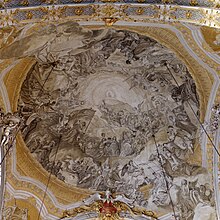Ladies' Collegiate Church (Munich)
The Roman Catholic women's collegiate church of St. Anna is a branch church of the Catholic parish church of St. Peter ("Alter Peter") in Munich . The Damenstiftskirche (Damenstiftstraße 1) is located in the Hackenviertel of the historic old town at Altheimer Eck.
history
1440 built Duke Albrecht III. from Bavaria-Munich a chapel at the house of the Indersdorfer monastery community in Altheim, at that time still an independent village in the area of today's street "Altheimer Eck". This chapel had to give way to a new Gothic building, which was built according to plans by Lukas Rottaler and inaugurated in 1496.
The monastery consecrated to St. Anna was founded in 1671 by Adelheid Henriette von Savoyen , wife of Elector Ferdinand Maria von Bayern .
After the construction of a new building for this Gothic church began in 1732, Elector Karl Albrecht, who later became Emperor Charles VII , had the foundation stone laid in 1733 for the new monastery church of the Salesian Sisters, who set up a monastery there in the legal form of a women's monastery. In gratitude for the birth of a hereditary prince, the elector gave special support to all three Annenkirchen in Munich from 1727, including the two other St. Anna churches in Lehel and Harlaching.
The architect of the late baroque church was Johann Baptist Gunetzrhainer , the furnishings were carried out by the Asam brothers . The church was consecrated in 1735.
The women's collegiate church was destroyed in the Second World War except for the outer walls. The reconstruction took place in 1960 under Erwin Schleich . Due to the fact that there were only black and white photos as a template, the decision was made to use a ceiling painting in sepia tones , as they did not want to use the wrong color for the fresco and also did not want to give the impression that it was an original. The three large altar leaves were implemented in a similar way. The figurative representation of the Lord's Supper is unusual in Bavaria .
The former women's monastery , which was founded by Electress Maria Anna for nobles, is now a secondary school. The number of canonesses was fixed at ten noble ladies. An age of 15 years and proof of 16 ancestors were prerequisites for admission to the specially built foundation and residential building. Elector Maximilian IV, who was very grateful to Maria Anna in gratitude for her commitment in the War of the Bavarian Succession . Joseph changed the statutes and the number of women from ten to 18. On February 18, 1802 , they and the abbess were guaranteed graduated financial contributions . Meanwhile, King of Bavaria, Maximilian IV Joseph stipulated on May 6, 1809 that ladies and fallen officers who were distinguished by their bravery should now be considered. As a result, the benefits were lower and the entry age was reduced to twelve years. Later the number of women was increased to 25 (large donation) and 48 (small donation). The monastery was merged with the Würzburg women's monastery of the same name as early as 1803 . Apartments were housed in the Munich monastery buildings. The buildings, which were badly damaged in 1944, were rebuilt after the war.
Architecture and program
The light facade with a high window above the portal in the middle part, which was framed on both sides by colored pilasters, is cautiously structured in Gunetzrhainer's classic Regency style .
The women's collegiate church is an addition of three individual rooms: an entrance yoke and vestibule with a gallery, then the central room with short side arms and behind that the rectangular choir room, each of which is vaulted by flat domes. On the one hand, the church interior appears closed, on the other hand, the desired separation between lay people and women religious who wanted to celebrate their services in peace and seclusion is achieved.
The church has three altars, the main altar showed a portrait of Anna Selbdritt by Joseph Ruffini as well as figures on both sides. The two side altars were decorated with altarpieces by Balthasar Augustin Albrecht (Francis de Sales) and George Desmarées (Visitation of the Virgin).
Special works
- Altarpiece of "St. Anna selbdritt "(Joseph Ruffini)
- Fresco homage to the angels (entrance yoke) ( Cosmas Damian Asam )
- Glory of the Apocalyptic Lamb (Dome Fresco) (Cosmas Damian Asam)
- Angel concert (fresco in the choir) (Cosmas Damian Asam)
- Glorification of St. Francis de Sales ( Balthasar Augustin Albrecht )
Specialty
On September 1, 2014, the Priestly Society of St. Petrus took over the pastoral care of the church at the women's church on behalf of the Archdiocese of Munich and Freising. Since then, a daily mass in the extraordinary form of the Roman rite has been offered.
Monastery building
South of the church is the monastery building of the women's monastery, which was built by Gunetzrhainer in 1739. The early classicistic stucco comes from Franz Xaver Feuchtmayer the Younger .
literature
- Karin Hösch: Munich - St. Anna women's collegiate church. Peda art guide No. 809, Passau 2011.
- Klaus Gallas : Munich. From the Guelph foundation of Henry the Lion to the present: art, culture, history . DuMont, Cologne 1979, ISBN 3-7701-1094-3 (DuMont documents: DuMont art travel guide).
- Alexander Langheiter: Discover the most beautiful Munich churches. J. Berg, Munich 2009, ISBN 978-3765842146 .
See also
Web links
Individual evidence
- ↑ Deutschlandspiegel 71/1960
- ↑ a b c Description of all orders, the images of which are contained in the color print work: "The orders, coats of arms and flags of all regents and states"., Author:? , Leipzig, 1883–1887.
Coordinates: 48 ° 8 ′ 14.4 " N , 11 ° 34 ′ 9.3" E





